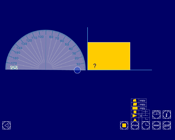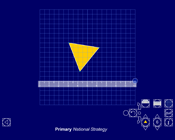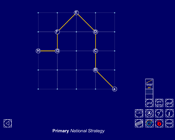Example review questions
Use a calculator to solve these problems.
- Tom buys some trainers for £24.99 and a new CD for £10.75. He pays with a £50 note. How much change does he receive?
- I have read 134 pages of the 512 pages of my book. How many more pages must I read to reach the middle?
- I think of a number, subtract 17 and divide by 6. The answer is 20. What was my number?
- There is space in a multi-storey car park for 17 rows of 30 cars on each of four floors. How many cars can park?
Consolidation and practice
These resources are to support children in guided or independent work.
Calculating angles

This interactive teaching program (ITP) is an ICT-based tool to support the exploration of angles. Calculating angles ITP allows the child or teacher to represent single or multiple shapes rotated around a central point in one, two or four quadrants. The size of angles can be estimated or calculated and confirmed using the on-screen protractor or reveal function.
Polygon

This interactive teaching program (ITP) is an ICT-based tool to support the exploration of shape, space and measure. Polygon ITP allows the child or teacher to represent regular polygons with three to ten sides. The ITP can then be used to explore the properties of regular and irregular shapes by dragging vertices and creating additional vertices. The ITP includes an on-screen protractor and ruler.
Fixing points

This interactive teaching program (ITP) is an ICT-based tool to support the exploration of shape and space. Fixing points ITP allows the child or teacher to create one or more shapes by connecting a number of vertices on a grid. Angles can be estimated and measured, and the effect of moving different vertices can be explored.
Opportunities to use and apply
Possible contexts include:
- using mathematics for a real purpose such as planning a school trip or deciding the best playground equipment to buy after a fund-raising event;
- making decisions within mathematics lessons and across the curriculum about when it is and isn’t effective to use a calculator.
Confirming learning
Ask probing questions such as:
- Angela buys 11 rolls of wallpaper. Eight of the rolls cost £4.80 each. The other rolls are sold at half price. How much do the 11 rolls cost Angela? Use a calculator to work out your answer.
- Write down the calculator key presses you made to solve the problem.
- Could you do the calculation with fewer key presses?
- What information did you use to solve the problem?
- How did you decide what calculations to do?
- What estimates did you make before you worked out the calculations?
- How did you check your answer?
 Calculating
Calculating


